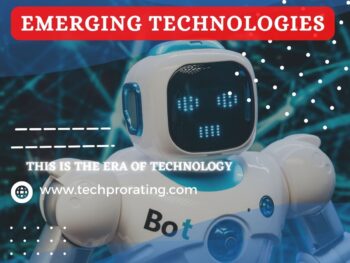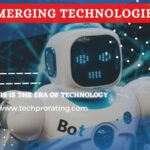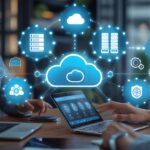Advanced technologies
Nowadays, the world has witnessed enormous technological advancements that are changing the way we live around. Advancements include Artificial Intelligence, Internet of Things (IoT), blockchain and 5G. The evolution of the tech landscape is faster than ever before. In this blog article, we’ll take a closer look at some of the most recent emerging technologies.
Advanced technologies refer to the latest and most innovative technologies that have been developed through extensive research and development efforts. These technologies often involve complex scientific and engineering concepts, and they are designed to push the boundaries of what is currently possible.
Examples of advanced technologies include artificial intelligence, machine learning, robotics, nanotechnology, biotechnology, quantum computing, and advanced materials. These technologies have the potential to revolutionize many aspects of modern life, from healthcare and transportation to communication and entertainment.
One of the defining characteristics of advanced technologies is their ability to continually evolve and improve over time. As researchers and engineers continue to work on these technologies, they are able to refine and optimize them, making them more efficient, powerful, and accessible.
Overall, advanced emerging communication technologies hold great promise for the future, and they will likely play a significant role in shaping the world in the years and decades to come.
Advanced technologies have transformed many aspects of modern life, and they are continuing to do so at an unprecedented pace. Top future technologies are not only enhancing existing industries and processes, but they are also creating new opportunities and fields of study.
One of the most exciting advancements in recent years is artificial intelligence (AI). AI is a branch of computer science that focuses on developing machines and systems that can perform tasks that would typically require human intelligence, such as learning, reasoning and problem-solving. AI technology is already being used in a variety of applications, from virtual assistants and chatbots to self-driving cars and predictive analytics.
Another area of advanced technology that is rapidly evolving is biotechnology. Biotechnology involves the use of living organisms or biological systems to develop new products or processes. This field encompasses a wide range of applications, from genetic engineering and gene editing to the development of new drugs and vaccines.
Nanotechnology is another area of advanced technology that holds great promise. Nanotechnology involves the manipulation of matter at the nanoscale, or the atomic and molecular level. This technology has the potential to revolutionize many industries, from healthcare and energy to electronics and materials science.
Advanced technologies are also creating new opportunities for entrepreneurship and innovation. Startups and tech companies are using these emerging technologies in business to develop new products and services, and they are disrupting traditional industries in the process. This has led to the rise of new business models and industries, such as the sharing economy and fintech.
As advanced technologies continue to evolve, it is likely that they will have an even greater impact on the world in the future. These technologies hold the potential to address some of the world’s most pressing challenges, from climate change and healthcare to transportation and energy. However, they also raise important ethical and societal questions, and it will be important to address these issues as these technologies continue to evolve.
Artificial Intelligence (AI)
Artificial Intelligence (AI) refers to the ability of machines and systems to perform tasks that would typically require human intelligence, such as learning, reasoning, problem-solving, and decision-making. AI is a branch of computer science that involves developing algorithms and systems that can simulate human cognitive abilities.
There are several different types of AI, including:
Reactive machines: These are strong AI systems that can only react to specific inputs without any memory or ability to learn.
Limited memory: These AI systems can store data from previous interactions and use that data to inform future decisions.
Theory of mind: These AI systems are able to understand human emotions, intentions, and beliefs, and use that understanding to interact more effectively with humans.
Self-aware: These AI systems have a sense of self and can understand their own internal state, which allows them to adapt to new situations and environments.
Engineering applications of Artificial Intelligence have a wide range, from virtual assistants like Siri and Alexa to self-driving cars and predictive analytics in healthcare. It is also being used in industries like finance, marketing, and manufacturing to automate processes and improve efficiency.
Despite the many benefits of AI, there are also concerns about the potential risks and challenges associated with its use. These include issues like bias and discrimination in AI algorithms, job displacement as automation becomes more prevalent, and the potential for AI systems to be used for nefarious purposes.
As AI technology continues to evolve AI projects, it will be important to address these issues and ensure that AI is developed and used in a way that benefits society as a whole.
One of the most significant advancements in AI in education in recent years has been the development of deep learning algorithms. These algorithms use neural networks modeled after the human brain to learn from vast amounts of data and improve over time. This has led to breakthroughs in areas like image and speech recognition, natural language processing, and predictive analytics.
Elements of AI are also being used to tackle some of the world’s most pressing challenges, such as climate change and healthcare. For example, AI is being used to analyze climate data and develop more accurate weather forecasts, as well as to identify potential solutions to reduce carbon emissions. In healthcare, AI in medicine is being used to analyze patient data and develop more personalized treatment plans, as well as to identify early warning signs of diseases like cancer and Alzheimer’s.
As AI technology becomes more advanced, it is also raising important ethical and societal questions. One of the biggest concerns is the potential for AI to perpetuate bias and discrimination, either through biased data or biased algorithms. This can lead to unintended consequences, such as discrimination in hiring or lending decisions.
Another concern is the potential for AI to displace human workers and exacerbate existing economic inequalities. While AI has the potential to create new jobs and industries, it may also lead to job losses in certain sectors and require workers to acquire new skills.
Finally, there are concerns about the potential for AI to be used for nefarious purposes, such as cyber attacks or autonomous weapons. It will be important to ensure that AI is developed and used in a way that aligns with ethical and moral values.
Overall, AI has the potential to revolutionize many aspects of modern life and address some of the world’s most pressing challenges. However, it will be important to address the potential risks and challenges associated with its use to ensure that it benefits society as a whole.
Artificial Intelligence technology has been around for decades, but it is only in recent years that it has really taken off. AI is essentially a computer system that can perform tasks that would normally require human intelligence, such as recognizing speech or images, solving problems, and making decisions.
The most well-known form of AI is Machine Learning, which involves training algorithms to identify patterns in large data sets. This enables computers to learn from experience and make predictions based on that learning. AI is being used in a variety of industries, from healthcare to finance, and it has the potential to revolutionize many areas of our lives.
One of the most exciting applications of AI is its potential to help us solve some of the world’s biggest challenges, such as climate change and disease. For example, AI algorithms can be used to analyze vast amounts of data on climate patterns, allowing scientists to make more accurate predictions and develop strategies to mitigate the impact of climate change.
Internet of Things (IoT)
The Internet of Things (IoT) refers to the interconnection of everyday objects and devices via the internet, allowing them to collect and exchange data. These objects can include anything from household appliances and wearable devices to industrial equipment and smart city infrastructure.
Iot applications work by embedding sensors, softwares, and network connectivity into objects and devices, enabling them to gather and transmit data. This data can then be analyzed and used to improve processes, create new products and services, and enhance user experiences.
One of the most significant benefits of IoT is its ability to improve efficiency and productivity in a wide range of industries. For example, in manufacturing, IoT solutions can be used to optimize supply chain management and improve production processes. In healthcare, IoT can be used to monitor patient health and improve the delivery of medical care.
IoT is also driving the development of new products and services, such as smart home devices and connected cars. These devices can be controlled and monitored remotely, making them more convenient and user-friendly.
However, there are also concerns about the security and privacy implications of IoT. Because IoT devices are often connected to the internet and gather large amounts of data, they can be vulnerable to hacking and cyber attacks. Additionally, there are concerns about the use of personal data collected by IoT devices and the potential for it to be used for unethical purposes.
As IoT technology continues to evolve, it will be important to address these concerns and ensure that IoT is developed and used in a way that benefits society as a whole. This may involve developing new security measures and regulations to protect users’ privacy and data, as well as ensuring that IoT is developed in a way that is accessible and equitable for all users.
Another potential benefit of IoT is its ability to create more sustainable and environmentally friendly systems. For example, IoT can be used to monitor energy usage in buildings and homes and adjust systems to optimize energy efficiency. It can also be used to monitor air and water quality and identify areas where pollution levels are high.
In agriculture, IoT can be used to improve crop yields and reduce water and pesticide usage. By embedding sensors in fields and using data analytics, farmers can better understand soil moisture, nutrient levels, and other factors that impact crop growth. This can help them optimize irrigation and fertilizer usage and reduce waste.
IoT is also driving the development of smart cities, which use connected devices and data analytics to optimize infrastructure and improve quality of life for residents. For example, smart traffic systems can use real-time data to optimize traffic flow and reduce congestion, while smart lighting systems can adjust lighting levels based on pedestrian and vehicle traffic to save energy.
However, there are also concerns about the potential for IoT to exacerbate existing inequalities and create new forms of discrimination. For example, if IoT devices are only accessible to certain groups or if they perpetuate bias and discrimination, they could create new barriers for marginalized communities.
Overall, IoT has the potential to revolutionize many aspects of modern life and create new opportunities for innovation and growth. However, it will be important to address the potential risks and challenges associated with its use to ensure that it benefits society as a whole. This will require collaboration between policymakers, industry leaders, and communities to ensure that IoT is developed and used in a way that is both responsible and equitable.
The Internet of everything is the network of physical devices, vehicles, home appliances, and other items that are embedded with sensors and connected to the internet. These devices can collect and exchange data, allowing them to interact with each other and with humans in real-time.
IoT has the potential to transform a wide range of industries, from manufacturing to retail. For example, manufacturers can use IoT sensors to monitor their production lines in real-time, improving efficiency and reducing downtime. Retailers can use IoT devices to track inventory and customer behavior, allowing them to make more informed decisions and provide a better shopping experience.
One of the biggest benefits of IoT is that it can help us improve our quality of life. For example, smart homes that use IoT devices can automate various tasks, such as adjusting the temperature, turning on the lights, and playing music, freeing up time for people to focus on other things.
Blockchain
Blockchain is a digital tally technology that allows for secure, transparent, and decentralized deals. It was firstly developed as the underpinning technology for cryptocurrencies similar as Bitcoin, but it has ago been applied to a wide range of diligence and use cases similar as blockchain exchange. At its core, a blockchain is a continuously growing list of records, called blocks, which are linked and secured using cryptography. Each block contains a cryptographic hash of the former block, a timestamp, and sale data. Once a block is added to the chain, it can not be altered, furnishing an inflexible record of all deals. One of the crucial benefits of blockchain is its capability to give a secure and transparent way to store and transfer data. Because data is stored on a decentralized network of computers rather than a single central authority, it’s less vulnerable to playing and tampering. Blockchain is being applied to a wide range of diligence, from finance and healthcare to supply chain operation and voting. For illustration, in finance, blockchain is being used to streamline processes similar ascross-border payments and trade finance. In healthcare, blockchain is being used to securely store and partake patient data between different healthcare providers, perfecting the delicacy and speed of judgments . In force chain operation, blockchain is being used to give lesser translucency and traceability, allowing companies to track the movement of goods from source to destination. This can help help fraud, counterfeiting, and other illegal conditioning. still, there are also enterprises about the scalability and energy consumption of blockchain networks, as well as the eventuality for blockchain to immortalize inequality and demarcation if it isn’t developed and used in an indifferent way. Overall, blockchain has the implicit to revise numerous diligence by furnishing a secure, transparent, and decentralized way to store and transfer data. still, it’ll be important to address the implicit pitfalls and challenges associated with its use to insure that it benefits society as a whole. In addition to its use in diligence and operations, blockchain has also given rise to new forms of decentralized associations and platforms. Decentralized independent associations( DAOs) are associations that are run by law rather than by a centralized authority. They use blockchain technology to enable transparent decision- timber, allowing stakeholders to share in governance and decision- making processes. Blockchain has also given rise to new forms of crowdfunding, similar as original coin immolations( ICOs) and security commemorative immolations( STOs), which allow companies to raise finances by issuing digital commemoratives. These commemoratives can be traded on blockchain- grounded exchanges and give investors with power or access to products and services. Blockchain is also being used to address social and environmental challenges. For illustration, blockchain can be used to track carbon emigrations and grease carbon trading, creating new impulses for companies to reduce their carbon footmark. Blockchain can also be used to enable secure and transparent voting, helping to insure fair and accurate choices. As with any new technology, there are also pitfalls and challenges associated with blockchain. For illustration, the decentralized nature of blockchain can make it delicate to apply regulations and help illegal conditioning similar as plutocrat laundering and terrorist backing. The use of blockchain can also have counteraccusations for sequestration and data protection, as data stored on the blockchain is inflexible and delicate to cancel. In conclusion, blockchain has the implicit to revise numerous aspects of ultramodern life by furnishing a secure, transparent, and decentralized way to store and transfer data. still, it’ll be important to address the implicit pitfalls and challenges associated with its use to insure that it benefits society as a whole. This will bear collaboration between policymakers, assiduity leaders, and communities to insure that blockchain is developed and used in a way that’s both responsible and indifferent Blockchain is a digital tally that uses cryptography to secure deals and cover the sequestration of the druggies. It’s best known as the technology behind cryptocurrencies, similar as Bitcoin, but it has numerous other implicit uses. One of the crucial benefits of blockchain is that it’s decentralized, meaning that no single reality controls the data. This makes it more secure and transparent, as data is stored on multiple computers and can be vindicated by anyone. Another benefit of blockchain is that it can help reduce costs and increase effectiveness in diligence similar as finance and force chain operation. For illustration, fiscal institutions can use blockchain to securely and snappily process deals, reducing the need for interposers and speeding up the process. Supply chain operation can use blockchain to track the movement of goods, reducing the threat of fraud and perfecting translucency.
5G
5G, or fifth generation, is the latest mobile network technology that promises faster speeds, lower latency, and greater connectivity. It builds on the previous generations of mobile network technology (2G, 3G, and 4G) and is expected to enable a wide range of new applications and services.
One of the key benefits of 5G core is its ability to provide faster data transfer speeds, with speeds up to 100 times faster than 4G. This will allow for real-time streaming of high-quality video, faster downloads, and smoother online gaming experiences.
Another benefit of 5G is its lower latency, which is the time it takes for data to travel from one device to another. 5G is expected to provide latency as low as one millisecond, which will enable new applications such as remote surgery and autonomous vehicles.
5g iot companies provide greater connectivity, with the ability to connect up to one million devices per square kilometer. This will enable the development of new applications and services such as smart cities, where sensors and devices can be used to optimize infrastructure and improve quality of life for residents.
However, the rollout of 5G has also raised concerns about its potential impact on human health and the environment. Some studies have suggested that exposure to 5G radiation may cause adverse health effects, although the scientific consensus is that 5G is safe for human health. There are also concerns about the energy consumption of 5G networks, as they require a large number of base stations and other infrastructure.
Overall, 5G has the potential to revolutionize mobile communications by providing faster speeds, lower latency, and greater connectivity. It will enable the development of new applications and services that were not possible with previous generations of mobile network technology. However, it will be important to address the potential risks and challenges associated with its use to ensure that it benefits society as a whole. This will require collaboration between policymakers, industry leaders, and communities to ensure that 5G is developed and used in a way that is both responsible and equitable.
Another benefit of 5G is its ability to support massive machine-type communications, which will enable the development of the industrial Internet of Things (IoT) on a larger scale. With 5G, sensors and devices can be connected to the internet and communicate with each other in real-time, enabling new applications and services such as smart homes and industrial automation.
Visible 5G is also expected to have a significant impact on industries such as healthcare, where it will enable the development of new applications such as remote monitoring and telemedicine. With its low latency and high bandwidth, 5G will enable doctors and patients to communicate in real-time, enabling faster diagnosis and treatment of medical conditions.
In addition, 5G is expected to have a significant impact on the entertainment industry, enabling new forms of immersive experiences such as virtual and augmented reality. With its fast speeds and low latency, 5G will enable users to experience high-quality content and interact with it in real-time.
The rollout of 5G also presents significant opportunities for businesses, with the potential to create new revenue streams and increase productivity. 5G will enable businesses to improve their operations through automation and the use of data analytics, enabling them to optimize their processes and increase efficiency.
However, the rollout of 5G has also raised concerns about its potential impact on privacy and security. With the ability to connect millions of devices and sensors, there is a risk that sensitive data may be compromised. There is also a risk that malicious actors may use 5G networks to launch cyber attacks.
Overall, 5G has the potential to revolutionize many aspects of modern life, providing faster speeds, lower latency, and greater connectivity. It will enable the development of new applications and services that were not possible with previous generations of mobile network technology, and have a significant impact on industries and businesses. However, it will be important to address the potential risks and challenges associated with its use to ensure that it benefits society as a whole. This will require collaboration between policymakers, industry leaders, and communities to ensure that 5G is developed and used in a way that is both responsible and equitable
5G is the fifth generation of mobile networks and it promises to revolutionize the way we use our devices. It is faster and more reliable than previous generations, with download speeds of up to 20 times faster than 4G. This means that we can stream video, play online games, and download files at lightning-fast speeds.
5G also has the potential to transform a wide range of industries, from healthcare to transportation. For example, 5G networks can be used everywhere.











